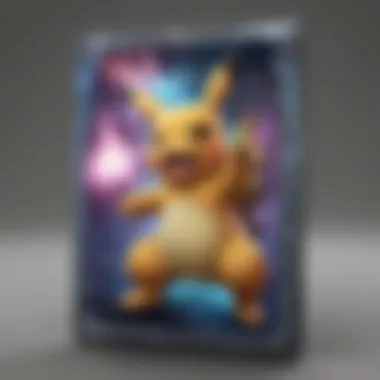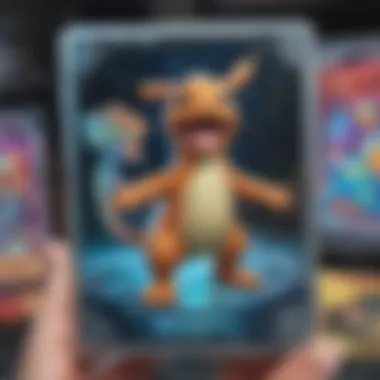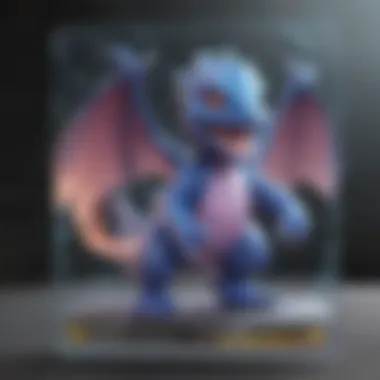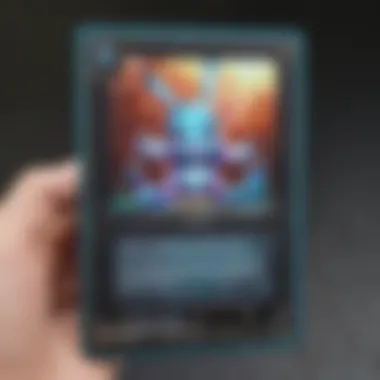Exploring 3D Holographic Cards in Gaming


Intro
Exploring the universe of Pokémon games opens a treasure trove of delightful experiences and innovations. At the core of this journey lies an exciting element—the 3D holographic cards. This technology doesn’t simply add a flashy aesthetic to card collections; it enhances the entire gaming experience. Your collectible cards, once stationary pieces of art, are transformed into dynamic entities that interact with gameplay. But before we dive into the specifics of these cards, it is essential to understand the foundation on which they stand: the Pokémon games themselves.
Prolusion to 3D Holographic Cards
3D holographic cards represent a captivating intersection of technology and creativity in the gaming world. With their ability to pull players into a visually stunning realm, these cards add a layer of interactivity and engagement that traditional cards cannot offer. Particularly for Pokémon fans, they elevate the collecting game from merely acquiring cards to experiencing them in a multidimensional space. This article explores this fascinating territory, zeroing in on how these cards enhance the overall experience of Pokémon gameplay, while also considering their implications for collectors and the gaming market.
Defining Holographic Technology
Holographic technology, in simple terms, relates to methods that enable the recording and display of three-dimensional images. Unlike typical photographs that capture a two-dimensional view, holograms make it possible to see the image from different angles as if it were a real object. At the heart of this tech lies a laser, which is used to create patterns of light that form the basis of a hologram. These patterns are captureed onto a medium, which retains the light interference pattern. When light hits this medium again, it reconstructs the three-dimensional image, often eliciting a ‘wow’ factor for those beholding it.
In practical applications, particularly in gaming, holographic cards leverage this technology to create vibrant, dynamic visuals that shift and change as the card is tilted or rotated. This immersive effect captivates players and collectors alike, adding emotional value to each card's aesthetic.
Historical Background of Holograms
The concept of holography isn't a new phenomenon—it dates back to the late 1940s when physicist Dennis Gabor first theorized the technique while working on electron microscopes. However, it wasn’t until the 1960s, following advancements in laser technology, that tangible holograms became a reality. The first practical holograms were produced by Gabor's contemporaries, and the field blossomed, witnessing significant advancements over the decades.
In the late 20th century, as technology progressed, holograms began to appear in security features, films, advertising, and eventually, in collectibles such as trading cards. This evolution marked a turning point where holograms transformed from a scientific curiosity to mainstream entertainment—and all the while, they captivated audiences through their mesmerizing three-dimensional visuals.
As holography found its way into card design, Pokémon, with its vast array of characters and lore, harnessed this technology to invite players into an enchanting world, turning card collecting into an interactive experience. Nowadays, 3D holographic cards hold significant cultural and collectible value, reaching far beyond their original conceptualization.
Mechanics Behind 3D Holographic Cards
The mechanics of 3D holographic cards are at the core of their captivating allure in gaming, particularly within the realm of Pokémon. To truly appreciate their impact, it’s essential to unpack the fundamental principles that drive their creation and functionality. Understanding these mechanics not only highlights why these cards have become significant in the collecting community, but also showcases their potential influence on gameplay itself.
Principles of Holographic Projection
Holographic projection is a complex yet fascinating process. To break it down, let’s start with light—specifically, how it behaves when it meets a surface. In a holographic card, multiple light sources create different angles of reflection, giving the illusion of depth and dimensionality. Unlike traditional two-dimensional images, holograms utilize interference patterns that capture light waves. These patterns are embedded into the material of the card itself, allowing for a three-dimensional optical illusion that changes as the angle of view shifts.
To visualize this, consider standing in front of a stunning mountain landscape photographed on a flat postcard. Now imagine the same scene represented in a holographic format; as you walk by, you can almost see different features of the mountain as the light dances across its surface. It’s this shifting perspective that enchants players and collectors alike, making the experience more immersive than ever before.
"The beauty of holographic cards lies in their ability to draw players into a world where visuals step off the page, reshaping their gaming experience."
Materials and Manufacturing Processes
The crafting of 3D holographic cards combines innovation with precision. The materials used range from high-quality plastic to specialized films that are engineered to capture and reflect light optimally. Here’s a closer look at some key components involved in their production:


- ** photo-sensitive films**: These are crucial for capturing images, as they react to light exposure to create a detailed hologram.
- Laser technology: High-powered lasers are essential in the recording process, allowing for the accurate encoding of the holographic image onto the card. The precision of laser alignment cannot be overstated—misalignments can lead to distorted images.
- Protective coatings: To ensure longevity and durability, many holographic cards are coated with materials that resist wear and tear from handling and environmental factors.
The manufacturing process itself is meticulous. It often involves multiple stages:
- Image design and encoding: Artists create intricate designs that will ultimately become holographic images.
- Laser recording: The encoded image is then recorded onto the holographic medium using lasers.
- Development and drying: Like a photo, these mediums must be developed and dried without exposing them to excess light to preserve the holographic qualities.
In short, the mechanics and materials behind 3D holographic cards are not only fascinating in their own right but also significantly enrich the Pokémon experience. They transform flat card collections into interactive elements that resonate with both nostalgia and excitement.
The Role of 3D Holographic Cards in Pokémon
3D holographic cards have etched out a significant niche in the Pokémon gaming landscape. They are more than just shiny cards; they offer a multi-layered experience that captivates collectors and players alike. Beyond visuals, these cards integrate innovative technology that changes how fans experience Pokémon. Their role extends into gameplay and collecting, reshaping communal interactions that fanatics of all ages enjoy.
Integration with Pokémon Gameplay
In gameplay, 3D holographic cards serve as a bridge between the physical and digital aspects of Pokémon. Players can use these cards to unlock special features or access exclusive digital Pokémon in various Pokémon games. The appeal lies in the interaction—imagine pulling out your holo card during a match; it feels like you're bringing a piece of the Pokémon world into reality.
Furthermore, the dynamic visuals found in these holographic creations often correlate with in-game effects. When a card is played, it can trigger stunning animations that enhance the gaming experience. This synergy creates an immersive environment that players crave, enabling them to connect more deeply with their Pokémon and the game itself.
Consider some examples: a player activating a rare holographic card of Charizard may watch as vibrant colors swirl before transitioning into an epic battle scene. The card becoms not just a collection piece but a tool that actively participates in the gameplay. This convergence of art and function fosters a unique relationship with the game, making every match feel fresh.
Enhancing the Collecting Experience
When it comes to collecting, the thrill of obtaining a holographic card cannot be overstated. Many fans experience a rush much like what you’d feel at a surprise birthday party when they pull a rare card from a booster pack. The allure of holographic cards comes from their aesthetics and knwledge that owning one can hold significant value in both personal and market terms.
The design of holographic cards is also pivotal in augmenting the collecting experience. They often showcase vibrant artwork and special effects that leap from the card, captivating collectors. The shimmering surface alone can transform casual collectors into ardent enthusiasts.
With communities forming around these cards on fabulous platforms such as reddit.com or facebook.com, enthusiasts share their latest hauls and trade for elusive pieces. This camaraderie enriches the collecting journey, as stories and experiences are exchanged, breathing life into each card's backstory.
Moreover, market dynamics come into play. The rarity of each card frequently dictates its trade value. Cards with stunning holography often become the crown jewels of collections, sometimes fetching exorbitant prices at auctions. Players and collectors alike find themselves on a relentless hunt, navigating local shops or searching online marketplaces to upgrade their collections.
"The beauty of holographic cards lies not only in their appearance but also in the experiences they cultivate—be it in gameplay or as cherished collectibles."
Design and Aesthetics of Holographic Cards
The design and aesthetics of holographic cards are pivotal in distinguishing them within the gaming world, especially in enhancing the allure of Pokémon. A well-crafted card not only appeals to the eye, but also serves as a vital element in creating an immersive experience for players and collectors alike. This section breaks down the artistic decisions and aesthetic considerations that elevate these cards beyond mere collectibles to integral parts of the gaming experience.
Artistic Styles and Trends
Holographic cards are essentially canvases that exhibit a variety of artistic styles borrowed from both traditional and modern art. The use of bold colors and high-resolution images creates an immediate impact. For instance, some cards incorporate retro graphic styles reminiscent of early 90s animation, harkening back to the formative years of the Pokémon franchise. Others might trend towards a more minimalist aesthetic, with clean lines and subtle gradients that evoke a sense of sophistication.


Players will find a range of holo effects that vary widely. For example:
- Prism and Rainbow Patterns: These create a dynamic visual effect that shifts with the light, enhancing the card's appeal.
- Textured Finishes: Some cards include embossing, making them distinct to the touch as well as visually.
- Illustrated Elements: Original artwork, especially that sourced from renowned artists, tends to stand out and can dramatically increase a card's collectibility.
The trends in design are ever-evolving, often reflecting broader cultural movements or advancements in printing technology. Many modern designs seek to integrate not just the iconic Pokémon characters, but also features from the digital realm, such as augmented reality, which can offer players a peek into a larger kinetic narrative beyond the flat surface of the card.
Impact of Visual Elements on Player Engagement
Visual elements play a crucial role in captivating and maintaining the interest of players. Aesthetic details can significantly influence how players perceive the brand and their emotional connection to the game. For instance, a bright, dynamic holographic card can foster excitement and anticipation. This leads to increased engagement, inviting players to explore more of what the game has to offer.
Additionally, the interpretive nature of designs can prompt discussion among fans, creating communities that revolve around shared interests in particular cards or themes. This enhances the social aspect of gaming, as players gather, trade, and discuss their favorite cards.
"The art of a card isn't just about visual appeal; it's about storytelling, conveying depth and character through aesthetics."
Moreover, attention to visual clarity is vital. If a card is overly busy or lacks a clear focal point, it can distract from the gameplay experience. Balancing complexity and clarity allows for an invite into the card's narrative without overwhelming players. Ultimately, from vibrant designs to the subtleties of texture and finish, every aesthetic decision reflects on the overall player experience, making it a fundamental component worth exploring in the context of holographic cards.
Market Dynamics of Holographic Cards
Understanding the market dynamics of 3D holographic cards gives a clearer picture of their role in gaming and collecting culture, notably in franchises like Pokémon. These cards aren’t just pretty pictures; they represent a convergence of art, technology, and commerce, all of which play significant roles in determining their value and desirability.
Value Assessment in Collectibility
When evaluating the collectibility of holographic cards, several factors come into play. The foremost are rarity and aesthetic appeal. For instance, cards that were released in limited quantities often fetch a higher price among collectors. Take the Charizard holographic card – its scarcity and iconic status among fans turn it into a prized possession. Pricing can vary vastly based on condition, which is commonly assessed using the Gem Mint scale. Cards graded higher tend to draw enthusiasts who are willing to pay top dollar.
Moreover, the behavior of the collector community can significantly influence card values, which fluctuates much like a stock market. Events such as Pokémon trading events, conventions, and online marketplaces can create sudden spikes in interest and demand for specific cards.
Factors to consider in value assessment include:
- Release History: Limited edition cards historically have higher value.
- Condition: Grading systems establish a baseline for worth.
- Popularity: Top-tier Pokémon characters evoke greater collector interest.
All these aspects result in a dynamic market where prices are not fixed but instead influenced by changing trends and collector behavior.
Current Trends in Selling and Trading Holographic Cards
As the digital age marches forward, new methods of buying and selling have played a pivotal role in shaping the market for holographic cards. While traditional stores still exist, there are a growing number of online platforms where transactions occur. Websites such as eBay, Facebook Marketplace, and even dedicated trading forums on reddit.com allow for a vibrant second-hand market.
Another recent trend is the rise of NFTs (Non-Fungible Tokens). Although in different realms, the introduction of digital collectibles shares some similarities with holographic cards. This has sparked conversations among collectors about the combination of physical and digital assets, opening doors for a potential hybrid market.
Key trends currently shaping the market include:


- Online Trading Platforms: Increasing reliance on websites for buying, selling, and trading cards.
- Social Media Influence: Platforms like Instagram showcasing collections fuel interest and set market standards.
- Event Hosting: Local and global trading events boost community engagement, impacting prices and availability.
"In the trade of holographic cards, community engagement is everything. When collectors come together, the energy often results in surprising shifts in value and interest."
Overall, the market for holographic cards is a complex web of interactions, driven by individual preferences, collective trends, and the ever-changing landscape of gaming culture. The dynamics at play not only influence the values but also foster a thriving community of collectors who share a passion for these unique pieces of art.
Technological Innovations and Future Developments
The realm of 3D holographic cards is not just a passing fancy in the gaming community; it represents a leap forward in technology that has captured the imaginations of die-hard fans and casual players alike. Embracing new advancements enables manufacturers and designers to enhance player experience significantly. These innovations are not merely about adding flair; they fundamentally alter how players engage with their favorite games, particularly the beloved Pokémon franchise.
Advancements in Holographic Technology
Recent developments in holographic imaging have introduced technologies that enable more vibrant and realistic representations. For instance, light field technology allows images to be viewed from different angles without losing integrity. Thus, the 3D perception feels more authentic, creating a lifelike experience. As the market evolves, these cards could soon incorporate dynamic images that respond to gameplay—imagine a holographic Charizard that appears to take flight when certain conditions in the game are met.
Additionally, advancements in materials science are improving the process of creating these cards. Micro-etching and nanostructuring techniques make it possible to produce holograms at a finer resolution. This sharp detail could transform how collectors observe and showcase their cards. Collectors will be looking for these innovations, as they will undoubtedly raise the value and desirability of holographic cards. In a culture centered around collectibles, the impact of these technological strides will be substantial.
Potential Applications Beyond Gaming
While holographic cards have primarily carved out a niche in gaming, their applications extend far beyond the Pokémon universe. For starters, the entertainment industry is starting to explore how holograms can enhance live performances. Imagine your favorite band putting on a concert where holographic images of the musicians appear in different lights and angles, further engaging the audience.
In the educational field, 3D holographic presentations can revolutionize how students learn. From biology to geometry, students can interact with three-dimensional models that help visualize complex concepts. Such immersion in learning could lead to better retention rates and increased interest in topics that might otherwise seem dull.
Furthermore, the collectible market is ripe for holographic technology. Brands like Pokémon already harness the power of nostalgia, but adding holographic elements can usher in a new wave of interest among collectors. As enthusiasts seek out those rare cards with high craftsmanship, the defining characteristics of cards could serve as the benchmark for future releases.
"Holographic cards are not just for gaming anymore; they’re a canvas for technology, art, and education, reflecting an evolution of how we interact with visual media."
In summary, the innovations in holographic technology do not only promise a thrilling future for gaming but also herald a new age for learning and interaction across multiple domains. With such exciting developments on the horizon, holographic cards are set to surprise us in ways we are only beginning to imagine.
Epilogue
As we wrap up this exploration of 3D holographic cards, it's critical to appreciate their place not just in gaming, but in the broader realm of collectibles and technology. These cards symbolize a fusion of art and science, marrying stunning visuals with engaging gameplay elements that resonate with Pokémon fans across generations. The allure of their interactive nature has not only changed the way players engage with the game but has also elevated the status of these cards to coveted trophies in the collecting world.
Summary of Key Insights
In this article, we’ve traversed several dimensions of holographic cards including their technical foundations and their evolving role in gaming culture. Key points to reflect upon include:
- Innovation in Gaming: Holographic cards represent a leap from static collectibles to dynamic elements that can influence gameplay and strategizing.
- Visual Appeal: The captivating designs of these cards enhance player experience, making them more than just tools for gameplay but also works of art.
- Market Value: Understanding the collectible market dynamics—the rarity, condition, and demand for certain cards—provides insight into why these cards are becoming increasingly valuable.
"Holographic cards are not just cards; they are a bridge between digital worlds and tangible collectibles."
Final Thoughts on the Impact of Holographic Cards
Looking ahead, the impact of 3D holographic cards in the gaming space is undeniable. They are not merely novelty items; they are pivotal in reshaping how players interact with their favorite games. As technology advances, we may see even greater potential in the fusion of holography and gameplay.
Furthermore, the implications of these advancements extend beyond the gaming community. The skills and technologies garnered from developing holographic cards could lead to significant innovations in areas like advertising, education, and virtual reality, opening a slew of new avenues for engagement.







